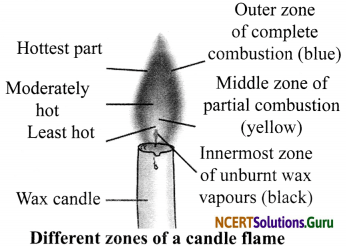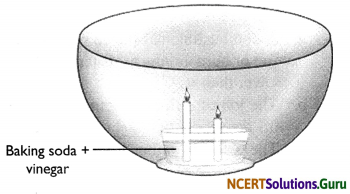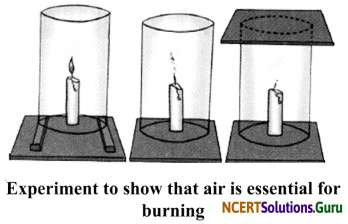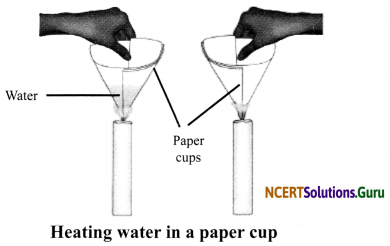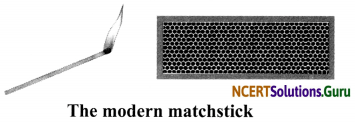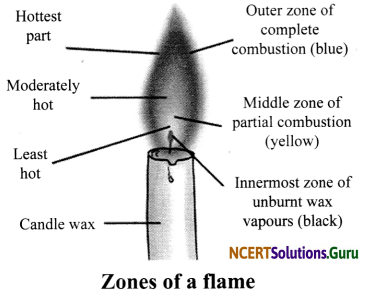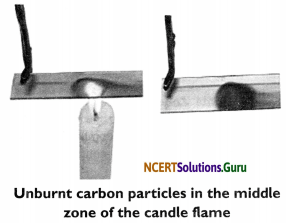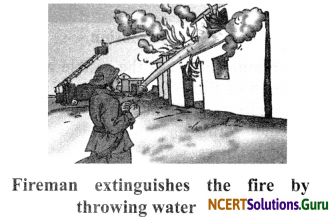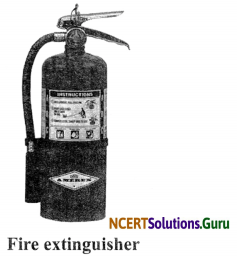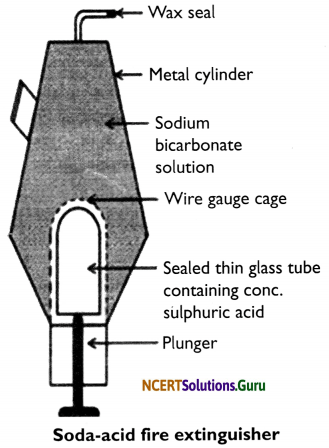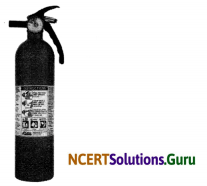NCERT Solutions for Class 8 Science Chapter 8 Cell – Structure and Functions
These NCERT Solutions for Class 8 Science Chapter 8 Cell – Structure and Functions Questions and Answers are prepared by our highly skilled subject experts to help students while preparing for their exams.
Cell – Structure and Functions NCERT Solutions for Class 8 Science Chapter 8
Class 8 Science Chapter 8 Cell – Structure and Functions Textbook Exercise Questions and Answers
Page-98
Question 1.
Indicate whether the following statements are True (T) or False (F).
a. Unicellular organisms have one-celled body. (T/F)
b. Muscle cells are branched. (T/F)
c. The basic living unit of an organism is an organ. (T/F)
d. Amoeba has irregular shape. (T/F)
Answer:
(a) True,
(b) False,
(c) False,
(d) True
Question 2.
Make a sketch of the human nerve cell. What function do nerve cells perform?
Answer:

The function of a nerve cell is to transmit messages to the brain and also from the brain to the receptor organs. Thus, it controls the working of different parts of the body.
Question 3.
Write short notes on the following:
a. Cytoplasm
b. Nucleus of a cell
Answer:
a. Cytoplasm: A jelly-like substance present between the cell membrane and the nucleus is called cytoplasm. Different cell organelles are present in the cytoplasm. Examples of cell organelles are mitochondria, Golgi body, ribosomes, lysosomes, chloroplasts, etc. The cytoplasm acts as a medium for the exchange of materials across the cell organelles.
b. Nucleus of a cell: This is a spherical structure which is present inside the celt usually at the centre of the cell. Nucleus is surrounded by a double membrane called nuclear membrane. A spherical structure called nucleolus is present inside the nucleus. Nucleus contains chromosomes which are thread-like structures carrying genes. These genes are responsible for transferring the characters from parents to their offspring.
Question 4.
Which part of the cell contains organelles?
Answer:
Cytoplasm is the part of the cell that contains various organelles such as mitochondria, ribosomes, Golgi bodies, etc.
![]()
Question 5.
Make sketches of animal and plant cells. State three differences between them.
Answer:


S. No. | Animal cell | Plant cell |
| I. | They are generally small in size. | They are usually larger than animal cells. |
| 2. | Cell wall is absent. | Cell wall is present. |
| 3. | Vacuoles are smaller in size. | Vacuoles are larger in size. |
| 4. | Plastids are absent in general. | Plastids are present. |
Question 6.
State the difference between eukaryotes and prokaryotes.
Answer:
| Prokaryotes | Eukaryotes |
| 1. Most prokaryotes are unicellular. | 1. Most eukaryotes are multicellular. |
| 2. The nucleus is poorly defined due to the absence of a nuclear membrane. | 2. The nucleus is well defined and is surrounded by a nuclear membrane. |
| 3. Nucleolus is absent. | 3. Nucleolus is present. |
| 4. Cell organelles such as plastids, mitochondria, Golgi bodies, etc., are absent. | 4. Cell organelles such as plastids, mitochondria, Golgi bodies, etc., are present. |
| 5. Bacteria and blue green algae are prokaryotic cells. | 5. Fungi, plant and animal cells are eukaryotic cells. |
Question 7.
Where are chromosomes found in a cell? State their function.
Answer:
Chromosomes are found inside the nucleus. Chromosomes are responsible for the inheritance of characters from one generation to the next.
Question 8.
‘Cells are the basic structural units of living organisms’. Explain.
Answer:
All organisms are made up of cells. The way a building is made up of bricks, an organism is made up of cells. Many cells group together to make a tissue. Many tissues come together to make an organ which in turn come together to make an organ system. Many organ systems together make an organism. Thus, it is clear that cells are the basic structural units of living organisms.
Question 9.
Explain why chloroplasts are found only in plant cells?
Answer:
Chloroplasts contain a green pigment called chlorophyll. This green pigment is important for photosynthesis in green plants. This chlorophyll pigment traps solar energy and utilises it to manufacture food for the plant. Since animals do not photosynthesise, they do not require chlorophyll. Hence, chloroplasts are found only in plant cells.
![]()
Question 10.
Complete the crossword with the help of clues given below.
Across
1. This is necessary for photosynthesis.
3. Term for component present in the cytoplasm.
6. The living substance in the cell.
8. Units of inheritance present on the chromosomes.
Down
1. Green plastids.
2. Formed by collection of tissues.
4. It separates the contents of the cell from the surrounding medium.
5. Empty structure in the cytoplasm.
7. A group of cells.

Answer:
Across
1. Chlorophyll
3. Organelle
6. Protoplasm
8. Genes
Down
1. Chloroplasts
2. Organ
4. Membrane
5. Vacuole
7. Tissue
NCERT Extended Learning Activities and Projects
Question 1.
Visit a laboratory for senior secondary students in your school or in a neighbouring school. Learn about the functioning of a microscope in the laboratory. Also observe how a slide is observed under the microscope.
Hint:
Do it yourself.
Question 2.
Talk to the senior biology teacher in your school or a neighbouring school. Find out if there are diseases which are passed on from parents to the offspring. Find out how these are carried and also if these diseases can be treated. For this you can also visit a doctor.
Hint:
Yes, there are several diseases which are passed on from the parents to their offsprings. These are genetic diseases which are controlled by the chromosomes. Some examples include haemophilia, sickle cell anaemia, Huntington’s disease, etc.
Question 3.
Visit an agriculture extension centre in your area. Find out about genetically modified (GM) crops. Prepare a short speech for your class on this topic.
Hint:
Genetically modified or GM crops refer to the plants whose DNA (or specific genes) has been modified with the help of genetic engineering techniques and are then grown and cultivated. Mutation breeding was the earlier alternative to provide better yields where an organism is exposed to radiations or chemicals to bring permanent changes in the quality of the plant and its yield. The objectives were primarily to prevent the attack of insects and pests, resistance to diseases and changing environmental conditions, enabling a plant to grow in a different soil and climate than the one in which it normally grows. Golden rice is a variety of rice produced through genetic engineering to incorporate vitamin A in it. This improves the nutritional value of rice. Hence, required traits can be incorporated into the GM crops by genetic modifications.
![]()
Question 4.
Find out about Bt cotton from an agriculture expert. Prepare a short note on its advantages/disadvantages.
Hint:
But cotton is a genetically modified crop and a pest resistant variety. It contains a gene taken from the bacterium, Bacillus thuringiensis. This gene produces an enzyme which is poisonous to the pests. In this way, But cotton is able to produce this enzyme and kill the invading pests.
Activity 1
Objective: To study the permanent slide of Amoeba.
Materials Required: Slide of Amoeba and a microscope.
Procedure:
- Focus the microscope lens on the slide.
- Study the slide carefully and write your observations.

Observations:
- The body structure of Amoeba is irregular.
- The body of Amoeba has 3 main parts: plasma membrane, cytoplasm and nucleus.
- Amoeba has cytoplasmic projections called pseudopodia which help it in locomotion and feeding.
Cell Structure and Functions
- Tissue: A group of specialised cells which are similar in structure and work together to achieve a specific task is called a tissue.
- Organ: An organ is a group of tissues which together perform a specific function or specialised functions.
- Organ system: An organ system is a group of organs in which each organ performs a different function in order to complete a particular life process. For example, digestive system, respiratory system, etc.
A cell consists of three parts namely cell membrane, cytoplasm and nucleus.
Cell Membrane: Cell membrane is also called plasma membrane. It makes the boundary of a cell. It is composed of proteins and lipids, and is porous. It allows the entry and exit of various materials across it. Cell membrane is semi-permeable in nature which means that it allows only selected materials to pass through it. Following are the functions of a cell membrane:
- Cell membrane separates the contents of the cell from the external environment.
- Cell membrane provides protection to the cell.
- Cell membrane facilitates the exchange of materials between the cell and its external environment.

Cell Wall: Cell wall is an additional covering present next to the cell membrane in plant cells and in bacteria. Cell wall in plants is made up of cellulose. It gives additional strength and protection to the plant cells. It helps the plants to withstand variations in temperature, wind and atmospheric moisture.
![]()
Activity 2
Objective: To prepare a slide of onion peel cells and observe it under a microscope.
Materials Required: Onion bulb, glass slide, coverslip, safranin stain, dropper, brush and microscope.
Procedure:
- Cut a slice of onion peel and peel off its skin. Take out the thin membrane present between the two fleshy layers.
- Put this portion of the onion peel in water in the watch glass.
- With the help of a dropper, put one or two drops of safranin stain in the watch glass and mix well with the help of a brush.
- Transfer the peel to a clean and dry glass slide and cut the peel in a proper rectangular shape with the help of a blade or needle.
- With the help of a dropper, put one drop of glycerine on the stained onion peel kept on the slide and gently place a coverslip on it.
- Remove excess of glycerine by using filter paper and observe the slide under the microscope.

Observation: There are a large number of compactly arranged cells. These cells are rectangular in shape. Each cell has a membrane covered with another thick covering called cell wall. They have a jelly-like substance, called the cytoplasm, between the nucleus and the membrane.
Cytoplasm: A jelly-like substance present between the cell membrane and the nucleus is called cytoplasm. It is made up of basic elements found in the form of chemical substances like carbohydrates, proteins and water. Various other components of a cell are suspended in the cytoplasm.
Cell Organelles: Organelles are small structures scattered in the cytoplasm, that work together to carry out various life processes. There are various types of cell organelles that perform different functions. Some of these are as follows:
i. Mitochondria: Mitochondria are small sausage-shaped structures which provide energy in the form of ATP. Therefore, they are known as powerhouse of the cell.
ii. Plastids: Plastids are disc-shaped structures present only in plant cells. They can be of three types-chloroplasts, chromoplasts (provide colour) and leucoplasts (store food). The chloroplast is green in colour due to the presence of green pigment called chlorophyll. It is known as the kitchen of the celt because it helps plant to make food by the process of photosynthesis.
iii. Golgi bodies: These are membranous sac-like structures concerned with the secretion of useful substances such as enzymes and hormones.
iv. Endoplasmic reticulum: The endoplasmic reticulum is a network of membranous tubes that connect the cell membrane with the nuclear membrane and helps to transport the substances in and out of the cell.
v. Ribosome: Ribosomes are tiny structures found either attached to the surface of endoplasmic reticulum or scattered in the cytoplasm. They help in protein synthesis.
vi. Vacuoles: Vacuoles are sac-like structures in the cell. In mature plant cells, they occupy most of the space within the cell and help to store food, water and wastes. In animal cells, vacuoles are smaller and maybe larger in number. They also help in waste removal and digestion.
Nucleus: This is a spherical structure which is present usually at the centre of the cell. Nucleus is surrounded by a double membrane called nuclear membrane. A spherical structure called nucleolus is present inside the nucleus. Nucleus contains genetic material in the form of thread-like structures called chromosomes. These carry genes which are responsible for transferring characters from parents to their offspring. Based on this organisms are divided into two groups:
i. Prokaryotes: When nuclear material is not enclosed by a nuclear membrane, the organism is called a prokaryote. In other words, a true nucleus is absent in prokaryotes. Bacteria and blue-green algae are examples of prokaryotes.
ii. Eukaryotes: When nuclear material is organised and enclosed by a nuclear membrane, the organism is called a eukaryote. In other words, true nucleus is present in eukaryotes. Organisms other than bacteria and blue-green algae are eukaryotes. Animals, plants, fungi, etc., are all eukaryotes.
![]()
Activity 3
Objective: To observe the human cheek cells through temporary slide.
Materials Required: Slide, coverslip, toothpick, watch glass, methylene blue stain and microscope.
Procedure:
- Take a clean toothpick and gently scrap the inner side of the cheek.
- Put the epithelial scrapping in a drop of water on a glass slide and spread it evenly.
- Put a drop of methylene blue on the material.
- Put a drop of glycerine on it.
- Put a coverslip on the material taking care that no air bubbles enter.
- Remove extra glycerine with a filter paper.
- Examine the slide under the microscope.

Observation: The human cheek cells are irregular in shape and have a thin cell membrane. A central dense nucleus is also present.
Functions of Nucleus:
i. Nucleus controls the entire functioning of a cell.
ii. Nucleus contains genetic material and controls inheritance of characters, i. e., transfer of characters from one generation to the next generation.
Comparison between Plant Cell and Animal Cell:
| Animal cell | Plant cell |
| 1. Animal cells are generally smaller in size. | 1. Plant cells are larger than animal cells. |
| 2. Cell wall is absent. | 2. The plasma membrane of plant cells is surrounded by a rigid cell wall of cellulose. |
| 3. Except the protozoan Euglena, no animal cell possesses plastids. | 3. Plastids are present. |
| 4. Vacuoles in animal cells are numerous, small and peripheral. | 4. Most mature plant cells have a single, large central sap vacuole. |
| 5. Animal cells have a single highly complex Golgi apparatus. | 5. Plant cells have many simpler units of prominent Golgi apparatus called dictyosomes. |
| 6. Animal cells have centrosome and centrioles. | 6. Plant cells lack centrosome and centrioles. |

Class 8 Science Chapter 8 Cell – Structure and Functions Additional Important Questions and Answers
Very Short Answer Type Questions
Question 1.
Define a cell.
Answer:
Cell is the structural and functional unit of life.
Question 2.
Which organism has the smallest cell?
Answer:
Mycoplasma [a bacterium formerly known as pleuro-pneumonia-like organism (PPLO)].
Question 3.
Name the longest plant cell.
Answer:
Fibre of Ramie.
Question 4.
Name the layer outside the plasma membrane of a plant cell.
Answer:
Cell wall.
![]()
Question 5.
What are the basic components of a cell?
Answer:
Cell membrane, cytoplasm and nucleus are the basic components of a cell.
Question 6.
What is the common feature of all living organisms?
Answer:
All living organisms are made up of cells which coordinate to perform the various life processes.
Question 7.
A hen’s egg can be seen easily. Is it a cell or a group of cells?
Answer:
The egg of a hen represents a single cell and it is big enough to be seen by an unaided eye.
Question 8.
Name the device that is used to visualise cells in a laboratory.
Answer:
Microscope.
Question 9.
What is the minimum size that can be seen with a microscope?
Answer:
10-6M.
Question 10.
Define a unicellular organism.
Answer:
An organism which is composed of a single cell is called unicellular organism,
e. g., Amoeba.
Question 11.
Define a multicellular organism.
Answer:
An organism which is composed of more than one cell is called multicellular organism. E.g., humans.
![]()
Question 12.
What is tissue?
Answer:
A group of specialised cells which are similar in structure and work together to achieve a particular function is called a tissue.
Question 13.
What is an organ?
Answer:
A group of similar tissues which perform a specific set of functions is called an organ.
Question 14.
What are pseudopodia?
Answer:
Finger-like projections on the surface of the cell of Amoeba are called pseudopodia.
Question 15.
Which is the smallest cell of the human body?
Answer:
Sperm cell.
Question 16.
Which is the longest cell of the human body?
Answer:
Nerve cell.
Question 17.
Define genes.
Answer:
Gene is a unit of inheritance in living organisms which controls the transfer of a hereditary characteristic from parents to offspring.
![]()
Question 18.
Define vacuoles.
Answer:
The blank looking structures in the cytoplasm are called vacuoles.
Question 19.
What are plastids?
Answer:
The small coloured bodies in plant cells are called plastids.
Question 20.
Name the green coloured plastids.
Answer:
Chloroplast.
Short Answer Type Questions
Question 1.
Write a short note on plasma membrane.
Answer:
Plasma membrane also called as cell membrane, makes the boundary of a cell. It is composed of proteins and lipids. It is porous and allows various materials to pass through it. Cell membrane is semi-permeable in nature which means that it allows selected materials to pass through it.
Question 2.
What are the functions of the nucleus?
Answer:
Functions of nucleus are as follows:
- Nucleus controls all the functions of a cell.
- It controls the inheritance of characters, i.e., transfer of characters from one generation to the next.
![]()
Question 3.
What are the functions of pseudopodia?
Answer:
Functions of pseudopodia are as follows:
- Movement and locomotion
- Capturing food
Question 4.
Differentiate between unicellular and multicellular organisms.
Answer:
Unicellular organisms | Multicellular organisms |
| 1. The body of the organism is composed of a single cell. | 1. The body of the organism is composed of numerous cells. |
| 2. Maybe prokaryotic or eukaryotic in nature. | 2. Eukaryotic in nature. |
| 3. Vegetative/asexual reproduction takes place in general. | 3. Sexual type of reproduction takes place in general. |
| 4. A single cell carries out all the life processes. | 4. Different cells are specialised to perform different functions. |
| 5. Injury of the cell can cause death of the organism. | 5. Injury or death of some cells does not affect the organism as the lost cells can be replaced by the new ones. |
| 6. An example of a unicellular organism is Amoeba. | 6. Humans are multicellular organisms. |
Question 5.
What is meant by the term ‘cell division’? Why is cell division necessary?
Answer:
The process by which existing cells divide to form new cells is known as cell division. It is necessary to facilitate the growth of an organism, reproduction and to replace the dead cells.
Question 6.
What is protoplasm?
Answer:
Protoplasm is a fluid viscous substance of the cell and is surrounded by a membrane called plasma membrane. It can be said that protoplasm is cell minus cell membrane. In other words, the nucleus and the cytoplasm together constitute the protoplasm of the cell. It is constituted by different compounds such as water, carbohydrates, proteins, fats, nucleic acid and mineral salts.
Question 7.
Name four elements which form a major part of the protoplasm. What gives living nature to the protoplasm?
Answer:
Ninety-nine percent of protoplasm, by its weight, is made up of four elements, namely, carbon, hydrogen, nitrogen and oxygen. It also contains other elements and compounds such as water, carbohydrates, fats, proteins and mineral acids. Both the elements and the compounds in unique combination provide living nature to the protoplasm.
![]()
Question 8.
Describe the discovery of cell.
Answer:
An English researcher named Robert Hooke is credited with the discovery of the cell. In the year 1665, he observed thin slices of cork (a part of the bark of a tree) under a microscope and saw honeycomb structures in it. The slices of cork appeared to be composed of small compartments which were further separated by a wall. Even though, he observed dead cells of the cork, he discovered the building blocks of life and coined the term “cell”. Later, many scientists observed and studied about the cell and its components. They also developed the cell theory.
Question 9.
Why do plants have an extra outer covering called the cell wall?
Answer:
Plant cells are openly exposed to the environment. They need to be protected against the extreme variations of the environment, e.g., change in temperature, moisture, strong winds, etc, The cell wall gives protection from these agents. This becomes more important for plants because unlike animals, they cannot move to escape the harsh climatic conditions.
Question 10.
What is nucleolus?
Answer:
Nucleolus is a small, spherical and dense body present inside the nucleus. It is visible only with a microscope of higher magnification.
Question 11.
What are prokaryotes and eukaryotes?
Answer:
Cells having a well defined nuclear membrane to contain the chromosomes within are called eukaryotic cells and the organisms with such cells are called eukaryotes, e.g., Amoeba. Organisms with cells which do not have well defined nuclear membrane are called prokaryotes, e.g., bacteria.
Question 12.
What are the two types of organisms on the basis of number of cells?
Answer:
On the basis of the number of cells, organisms can be classified as unicellular and multicellular organisms.
- Unicellular organisms are the singled-celled organisms. They are made up of a single cell. Organisms like Amoeba, Paramecium, etc., are single-celled organisms.
- Organisms that consist of more than one cell are known as multicellular organisms, e.g., humans.
![]()
Question 13.
Describe the structure of a cell.
Answer:
A typical cell consists of three basic parts: (a) Cell membrane (b) Cytoplasm (c) Nucleus.
a. The cell membrane is also called a plasma membrane. This membrane separates the cells from one another. The plasma membrane is porous and allows the movement of selected substances across it. If forms the boundary of the cell.
b. The cytoplasm is a thick jelly-like fluid inside the cell membrane. It occupies the space between the cell membrane and the nucleus. Various cell organelles are suspended in it.
c. Nucleus is a central, dense and spherical structure present in the cytoplasm. It contains genetic material and controls all the functioning of the cell.
d. Cell wall is an additional rigid covering present in plant cells to provide protection and strength.

Question 14.
Describe the structure of onion peel cells with the help of a diagram.
Answer:
An onion is multicellular (consisting of many cells). As in all plant cells, the cell of an onion peel consists of a cell wall, cell membrane, cytoplasm, nucleus and a large central vacuole. The nucleus is present at the periphery of the cytoplasm. The vacuole is prominent and present at the centre of the cell. It is surrounded by cytoplasm.

Question 15.
Explain the structure of human cheek cells.
Answer:
As in all animal cells, the cells of the inner lining of human cheek do not possess a cell wall. A semi-permeable cell membrane surrounds the cytoplasm. Unlike plant cells, the cytoplasm in an animal cell is denser, granular and occupies a larger space. The vacuole is smaller in size, or absent. The nucleus is present at the centre of the cytoplasm.

Question 16.
Name a cell organelle found only in a plant cell and list its various types.
Answer:
Plastids are the cytoplasmic organelles found only in plant cells. On the basis of pigments, plastids are of three types:
- Leucoplasts (colourless plastids)
- Chloroplasts (green-coloured plastids)
- Chromoplasts (coloured plastids other than green)
Leucoplasts perform the storage of starch and oil drops. Chloroplasts contain chlorophyll and are mainly for photosynthesis. Chromoplasts are responsible for the characteristic colours of flowers and fruits.
![]()
Question 17.
Give the functions of the plant cell wall.
Answer:
- The plant cell wall provides definite shape, strength and rigidity to the plant cell.
- It helps in controlling cell expansion.
- It helps in preventing water loss from the cell.
- It is involved in transportation of substances across the cell as well as between two or more cells.
- It acts as a barrier between the cell interior and the outer environment.
- It helps to maintain the shape and size of the cell.
- It protects the plant cells from various disease-causing microbes.
- It provides rigidity to withstand mechanical stress.
Question 18.
Why do plant cells possess large sized vacuoles?
Answer:
Plant cells have distinct vacuoles. They use their vacuoles for transporting and storing nutrients, metabolites and waste products. Plants also accumulate water in their vacuoles when they become larger through turgor pressure driven by inward movement of water.
Question 19.
Shreyansh was taken to the biology lab along with other students where his teacher told the features and differences of plant and animal cells. They were told that plant cells generally have dead cells whereas animal cells have most of the component living in the cell. Shreyansh wants to know if these characters show any advantage.
Do the characters show any advantage to the plants and animals? If yes, what are they?
Answer:
Yes, plants do not have to locomote in search of food as they are autotrophs and so do not need much energy. But the dead cells present in plants provide rigidity to the structure. On the other hand, animals need energy for locomotion and other cellular functions.
Long Answer Type Questions
Question 1.
Explain the position and functions of nucleus in a cell.
Answer:
Nucleus is called the brain of a cell. It is situated within the cytoplasm. It is small in size and spherical in shape. It is filled by a gel-like substance called nucleoplasm. The nucleoplasm is surrounded by a thin nuclear membrane. The nucleoplasm and the cytoplasm together form the protoplasm.
The nucleus controls all the functions of a cell. It directs the functions related to the growth and working of organelles going on in the cell. Nucleus contains the genetic material of the cell in the form of thread-like structures called chromosomes. Chromosomes contain all the genetic information and pass it further to the offspring during reproduction.
Question 2.
What are the functions of the following in a cell-cell membrane, cytoplasm, vacuoles, mitochondria?
Answer:
- Cell membrane: The cell membrane separates the cell from its surrounding medium and helps in the selective transport of materials into and out of the cell.
- Cytoplasm: The cytoplasm is a jelly-like substance that makes up most of the inside of a cell. All life functions take place in the cytoplasm. It facilitates the functioning and coordination of various cell organelles suspended in it.
- Vacuoles: Vacuoles are sac-like structures. They store food, water and wastes and maintain the electrolyte balance of the cell.
- Mitochondria: Mitochondria are small sausage-shaped structures. They oxidise food to provide energy. They are, therefore, often called the powerhouses of the cell.
![]()
Question 3.
With the help of examples, explain the variation in shapes and sizes of the cells.
Answer:
In multicellular organisms, cells have special jobs, according to which they have different shapes and sizes.
- Nerve cells, for example, have fibres that may be more than one metre long. Message passes from one nerve cell to another along these fibres.
- Muscle cells expand and contract. Their long, thin shape helps them do this. The outer layer of skin forms a protective covering over the body. Their flat shape helps them to cover a larger area.
- White blood cells (WBCs) present in the blood can change their shape. This helps them to engulf and destroy the germs.
- Plant cells located on the outer part of the stem give strength to a plant. These cells have thick cell walls for support. Some cells in plants are used to store food. These cells are larger than other cells.
Question 4.
What are the main points of the cell theory of life?
Answer:
The main points of the cell theory of life are as follows:
- The cell is the basic structural and functional unit of life. All organisms are composed of cells.
- All celts arise from pre-existing cells. Each cell contains genetic material that is passed on to the next generation during this process.
- All the basic chemical and physiological functions, e.g., repair, growth, movement, immunity, communication and digestion, are carried out inside the cells,
- The activities of cells depend on the activities of sub-cellular structures within the cell. These sub-cellular structures include organelles, plasma membrane and nucleus.
Picture-Based Questions
Question 1.
Draw a labelled diagram of (a) Amoeba (b) Paramecium. Name the locomotory organs in both of them.
Answer:


Locomotory organs: Amoeba moves with the help of pseudopodia while Paramecium moves through cilia.
Question 2.
Draw a labelled diagram of a prokaryotic cell.
Answer:

Question 3.
Draw a well-labelled sketch of the plant cell.
Answer:

NCERT Solutions for Class 8 Science Chapter 8 Cell – Structure and Functions Read More »







